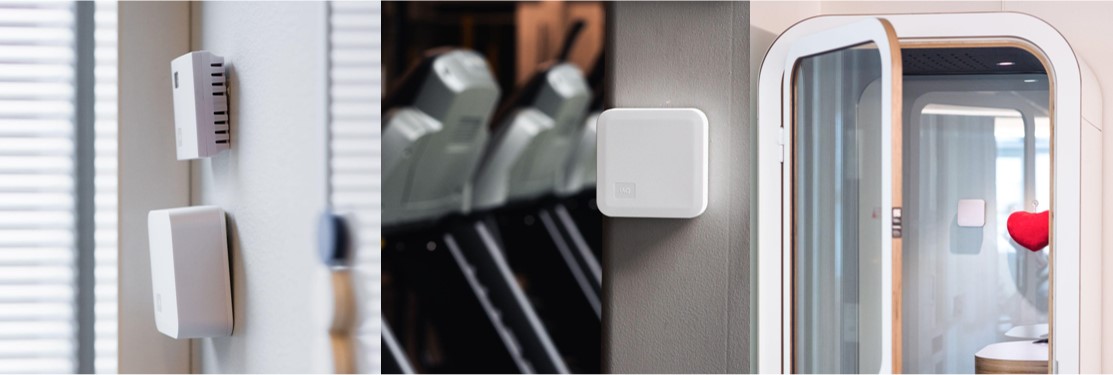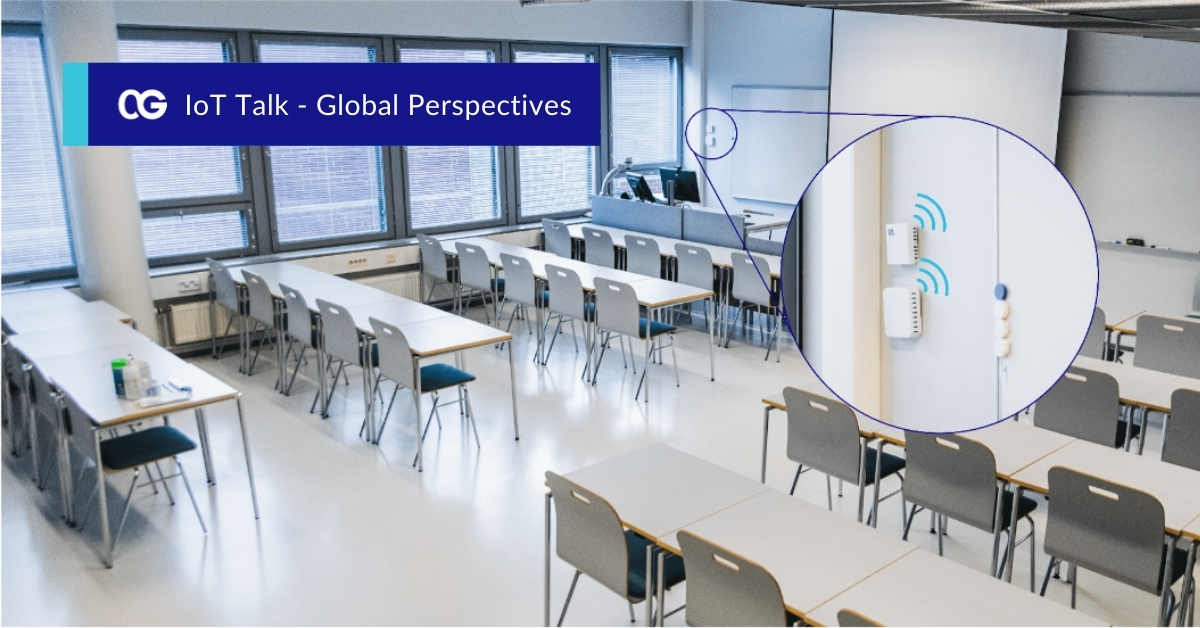0G United Nations: Breathing easy with IoT: monitoring indoor air quality for health and safety

No longer a nice-to-have: IoT solutions monitor the quality of the air we breathe to keep us safe, healthy and productive.
Indoor concentrations of some pollutants are often two to five times higher than typically outdoors’. Indoor air pollution has increased in recent decades as a result of reduced mechanical ventilation in the interests of energy efficiency, and increased use of synthetic building materials, furnishings, personal care products, pesticides and household cleaners.(1)
Worse still, it has been found these materials release toxic substances (PFAS) — so-called ‘forever chemicals’ because they do not break down. They accumulate in animals, as well as humans, and are linked to cancer, birth defects, liver disease, thyroid disease, decreased immunity, hormone disruption and a range of other serious health problems. Researchers with the University of Rhode Island and Green Science Policy Institute recently tested indoor air at 20 sites and detected the “forever chemicals” in 17 locations.
According to The Guardian,(2) the study published in Environmental Science & Technology used a new PFAS measurement technique for checking air. It found particularly high levels in several kindergarten classrooms and also checked the supply room of an outdoor clothing store, offices, several university classrooms, university labs and an elevator.
__________________________
In recent months the ease in which the delta variant of COVID-19 spreads through the air created huge awareness on indoor air quality and made improvement a global priority. The World Green Building Council cites an academic study that found enhancing indoor air quality could be as effective in reducing aerosol transmission of viruses as vaccinating 50-60% of the population.(3)
COVID-19 has changed the way we think about and value clean air
The World Health Organisation (WHO) released in March 2021 the “Roadmap to improve and ensure good indoor ventilation in the context of COVID-19.”
“Understanding and controlling building ventilation can improve the quality of the air we breathe and reduce the risk of indoor health concerns including preventing the virus that causes COVID-19 from spreading indoors.”(4)
Scientists lead the way for change
Lidia Morawska, Distinguished Professor in the School of Earth and Atmospheric Sciences at Queensland University of Technology, is one of the world’s foremost authorities on the impact of airborne particles on human health and the environment.(5)
She says it should be mandatory that building occupants get real-time information on the quality of the air they are breathing.
“Wide use of monitors displaying the state of indoor air quality must be mandated because the general public currently have no way of knowing the condition of indoor spaces they occupy and share with others. Visible displays will keep building operators accountable for air quality. The public should be made aware and demand safe environments.”
She is leading an international call for a ‘paradigm shift’ in combating airborne pathogens such as COVID-19, demanding universal recognition that infections can be prevented by improving indoor ventilation systems.(6)
Testing for specific atmospheric pollutants, or pathogens like COVID-19, can require complex and costly technology, but a good proxy for indoor air quality that can be easily measured is the level of carbon dioxide (Co2). We exhale CO2 when we breathe. So the higher the concentration above the outdoor level, the poorer the ventilation, and hence the greater the potential for pollution from other sources.
In addition to CO2, humidity and temperature are also strong indicators of the potential for an indoor environment to spread COVID-19.
An in-depth modelling study in China and the United States conducted in 2021 investigated the impact of temperature and relative humidity on the transmission of COVID-19. It found “Higher temperature and higher relative humidity potentially suppress the transmission of COVID-19.” The study found even a 1% variation of both measures could impact transmission rates.(7)
__________________________
Indoor air quality is a global priority
The achievement of good indoor air quality is a global priority, one of the United Nations’ 2030 Sustainable Development Goals (SDGs) to reduce inequality and mitigate the effects of climate change. Goal No 11 is focussed on sustainable cities and the environment. It calls for a reduction in the adverse per capita environmental impact of cities, including paying special attention to air quality. According to the WHO, tackling both outdoor and indoor air pollution is crucial to the achievement of these goals.(8)
The mandate for clean indoor air is gathering pace
Legislators are starting to take action against poor indoor air quality: it is a question of when, not if legislation will be widely introduced.(9)
Belgium holds employers accountable for ensuring safe air quality. “The employer is now required to carry out a risk analysis of indoor air quality and take into account the different sources of pollution: presence and physical activity of persons; presence of products and materials in the workplace; maintenance, repair and cleaning of the workplace and air quality provided by infiltration and ventilation, pollution and operation of ventilation, air treatment and heating systems. The employer must take the necessary technical and/or organisational measures to ensure that the concentration of Co2 in the workplace is generally less than 900 ppm.”(10)
The business benefits of clean workplace air
In most workplaces, unless there are specific sources of atmospheric pollutants that can be dealt with, maintaining good air quality largely means maintaining adequate ventilation. However there is a cost. Air needs to be pumped, and depending on the outside temperature, heated or cooled. So building managers aim for a compromise between cost and quality.
However research is increasingly revealing the impacts on worker productivity and wellbeing of poor air quality, suggesting that compromising on air quality could represent a false economy, but the costs are born, in most buildings, by tenant organisations, not building owners or managers.
Workers’ health and productivity can both be compromised by poor air quality in the workplace. And as modern buildings have become more efficient, they have also become more airtight, increasing the potential for poor air quality.
A 2015 US study, The Impact of Green Buildings on Cognitive Function,(11) found employees’ cognitive performance doubled in green building environments with enhanced ventilation compared to a conventional building environment.
“These results … suggest that the levels of carbon dioxide and volatile organic compounds that we commonly encounter in conventional office buildings are associated with decreases in worker performance compared to when those same workers are in green building environments. … When we enhance ventilation and optimise indoor environmental conditions, we see improvements in the cognitive function of workers.”
__________________________
In depth research by leading indoor air quality expert Joseph Allen, Harvard University, in 2015, demonstrated the impact of indoor air quality on worker productivity. “The results were dramatic. When volunteers worked in well-ventilated conditions (which lowered the levels of Co2 and VOCs), they scored 61% higher than when they worked in typical office building conditions. When they worked in the cleanest conditions, with even lower Co2 levels and higher ventilation rates, their scores climbed 101%.”(12)
“One of our biggest frustrations over the past year is that we knew enough to act early on.” Joseph Allen, Harvard University
The National Institute for Occupational Safety and Health found “If 20% of the work force has symptoms -- including watering eyes; hoarseness; headaches; dry, itchy skin; dizziness; nausea; heart palpitations; miscarriages; shortness of breath; nosebleeds; chronic fatigue; mental fogginess; tremors; swelling of legs or ankles; and cancer -- the building may be labelled a ‘sick building’. The telling factor is if the symptoms ease when workers are at home or on vacation.”(13)
Living with COVID
Countries have adopted different strategies to handle COVID-19, striving to balance its impact on people, the load on the health system and the impact of lockdowns on the economy. However, even those administrations that have been very successful to date in eliminating the virus or keeping infection rates very low now acknowledge that with the delta variant, elimination is impossible: we must learn to live with the virus. For employers, this will mean ensuring workplaces are safe and that everything reasonably possible is done to minimise spread. Maintenance of good air quality will make a significant contribution, and those employers that fail to address air quality will face consequences on multiple fronts:
- Failure in duty of care to employees, leading to possible damages claims
- Business disruption if large numbers of employees fall sick
- Significant adverse publicity with the link between indoor air quality and infection rates is well-established and well-known.
Depending on the nature of the workplace, ensuring good air quality could be as simple as opening windows or adjusting the heating/ventilation/air-conditioning system. But none of these things can be done without some means of monitoring air quality and raising an alert if it deteriorates beyond predetermined limits.

__________________________
Breaking the trade-off between low cost and good health
Building management systems (BMS) that control air quality in many workplaces are not the answer. These control heating, cooling and ventilation systems, and many offer air quality monitoring as an option. However, these are not optimal for occupants.
Most businesses operate out of leased premises, so building management is not under their control: it is the responsibility of the building owner/operator. These systems are designed to be monitored by building managers through specialist building management systems, not via a user-friendly smartphone app designed for use by anyone.
Furthermore, there is little incentive for building owners or operators to install air quality monitoring as it brings them no direct benefits and, until recently with low awareness of the importance of air quality and lack of data on air quality, there has been little pressure on them to monitor or improve it. And revealing poor air quality will drive demand for improvement, which could require costly upgrades to building ventilation and heating/cooling systems.
The spread of COVID-19 by airborne viruses has raised the profile of air quality enormously. It is highly likely that building operators will be under increasing pressure to pay attention to air quality, and that it will become a factor in the decision making of organisations seeking to lease premises.
In many BMS, monitors need to be hardwired into the building management network, and upgrading a BMS to provide air quality monitoring would mean contracting the system provider. This would be much more costly and take much longer than installing 0G Network connected air quality monitors.
But perhaps most important is control and ownership of data. Building management is rapidly shifting to becoming a data-driven industry. Data and the insights that can be gained from data are increasingly valuable. And those who own and control access to the data will seek to realise that value by building revenue-generating services around it.
Making the invisible visible and take control – monitor your indoor air quality
If you work in a building where you are concerned about the air quality and the level of ventilation or are accountable for the safety of people it is possible to instal and connect within minutes Co2, humidity or temperature sensors to monitor the actual air quality levels in rooms and send threshold alerts so immediate action can be taken to ensure readings are within recommended limits.
You should feel just as safe about the air you breathe as you feel about the water you drink. So it is essential for building occupants and operators to be able to monitor indoor air quality in real-time. And that is what IoT solutions deliver.
Tenants and stakeholders will increasingly demand indoor air quality assurances from building owners and operators because the potential health impacts of indoor air pollution represent a non-negotiable condition of employment.
Healthy buildings – with an IoT solution
Astute property owners and facilities managers (operators) have embraced the clear advantages of IoT enabled smart buildings that collect powerful data sets that enable them to operate buildings at optimal performance: buildings that are energy-efficient, yield longer equipment lifespans, enjoy a better property profile and improved tenant comfort and safety.
IoT enabled solutions liberate the building data and give much needed insights and control to the right person at the right time, enabling them to take the right action.
At the simplest level, an IoT solution to monitor indoor air quality consists of three key components: the battery-powered IoT hardware device and sensors monitoring continuously the air quality, the communication network, and the data platform or application providing real-time information anywhere and anytime.
The right solution requires no technology knowledge and minimal infrastructure. It can be deployed in minutes and does not need access to the building’s network or power supply. Its monitoring devices are highly reliable and provide accurate data. And the data they provide is accessible and available in a timely manner, delivered directly to the people who need it: via notification or application, anywhere, any time.
For speedy and safe deployment the IoT monitoring devices should simply connect to a public, reliable IoT network such as the 0G Network, powered by Sigfox technology and maintained by 0G Network Operators who assure high service levels.
Monitoring devices must be cost-effective to acquire and maintain. To minimise maintenance and avoid operational headaches, they must operate for years on a single battery.
Such a solution truly empowers the tenant to assure the health, wellbeing and safety of occupants and helps them manage the chain of responsibility.
This will become increasingly important for organisations with indoor workplaces around the world as administrations progressively implement different guidelines and regulatory requirements.
The writing is on the wall. The ability to monitor and manage indoor air quality will be at centre stage in post COVID-19 lock downtimes: for operational, health and safety; for risk management; to ensure business continuity.
No matter how you fix the problem – a monitoring solution will give you the facts and peace of mind that the chosen solution truly maintains the right air quality.
About 0G United Nations
0G United Nations is the international association of more than 72 0G Network Operators. Together they provide the only global 0G network, dedicated to the IoT and powered by Sigfox technology, the world-leading IoT communication service provider.
IoT enabled solutions liberate the building data and give much needed insights and control to the right person at the right time, enabling them to take the right action.0G Network members are dedicated to helping organisations adopting IoT solutions at scale. Their more than 2000 employees create together the largest body of knowledge for choosing the right IoT technology, deploying it with speed, and delivering measurable business outcomes at the lowest total cost of ownership, and in the most sustainable way.
0G UN members and their partners enable customers to accelerate data-driven business efficiencies by seamlessly connecting millions of sensors through the 0G network. They leverage scale to accelerate global IoT market adoption and unlock opportunities in a unified, efficient and effective manner. They are committed to ensuring IoT reaches its full potential and works in the most efficient way possible.
0G Network operator Connected Finland makes indoor air quality monitoring easy and globally available for any indoor environment.
The 0G Network operator Connected Finland operates nationwide 0G Networks in Finland and Estonia. It offers an indoor air quality monitoring service using AirWits air quality monitors that connect over its 0G Network. AirWits monitors, available through 0G network operators in more than 50 countries, can provide data to any preferred data platform or application, or can be delivered with Connected Finland’s FoxerIoT platform. It analyses data from the monitors and supports a dashboard that presents information to occupants over the web in a browser, or via a mobile phone app, or made available to any data platform. https://www.connectedfinland.fi/

The device
Connected AirWits air sensors are small (86 x 86 x 26mm) devices easily mounted or removed with screws or double-sided tape. They can operate for five years on three AA batteries in their default settings. Devices are able to run for up to 10 years or more with less data transmission intervals.
Connected AirWits air sensors are small (86 x 86 x 26mm) devices easily mounted or removed with screws or double-sided tape. They can operate for five years on three AA batteries in their default settings. Devices are able to run for up to 10 years or more with less data transmission intervals.
What gets measured
AirWits monitors measure:
AirWits monitors measure:
- Co2 levels
- Temperature and Humidity
- Dust and other particulate matters
- Volatile organic compounds (these can be emitted from paints and coatings, furniture, cleaning supplies and office equipment such as printers)
What users learn
The FoxerIoT data platform and the app monitor Co2 levels. Real-time alerts are sent when thresholds are reached and are supplemented by customisable weekly or monthly air quality reports by default.
The FoxerIoT data platform and the app monitor Co2 levels. Real-time alerts are sent when thresholds are reached and are supplemented by customisable weekly or monthly air quality reports by default.

